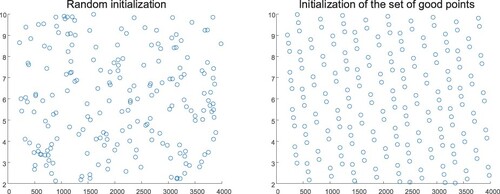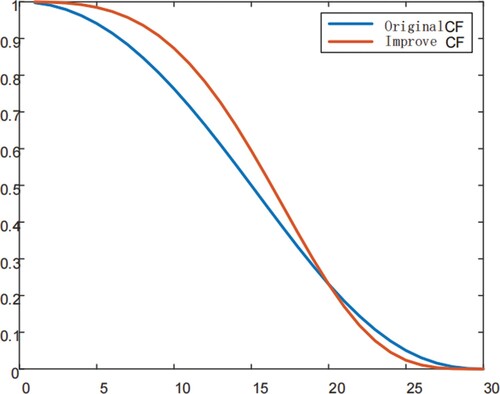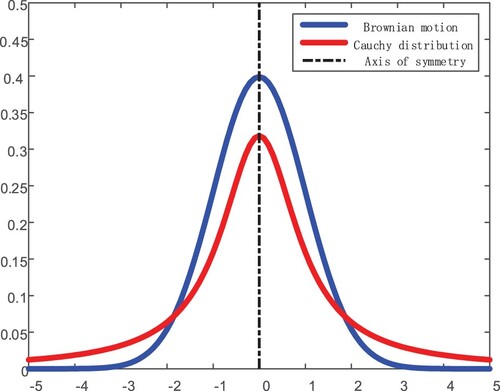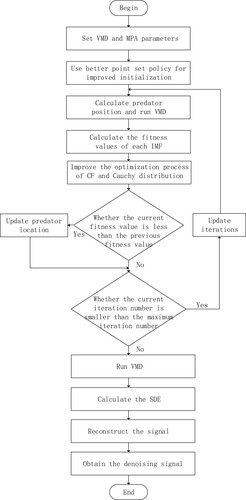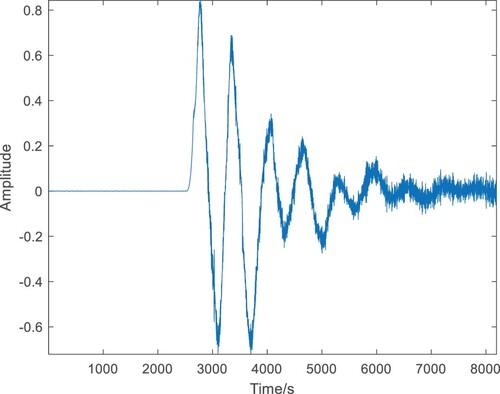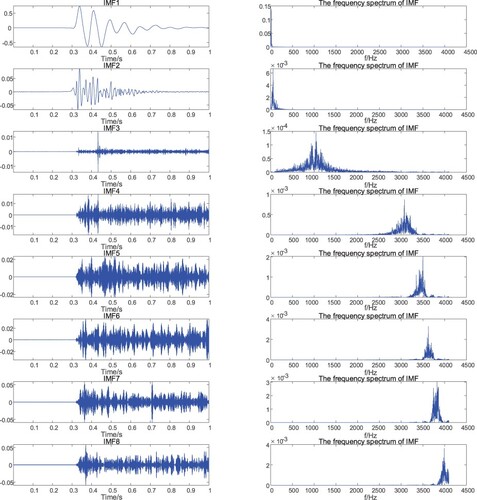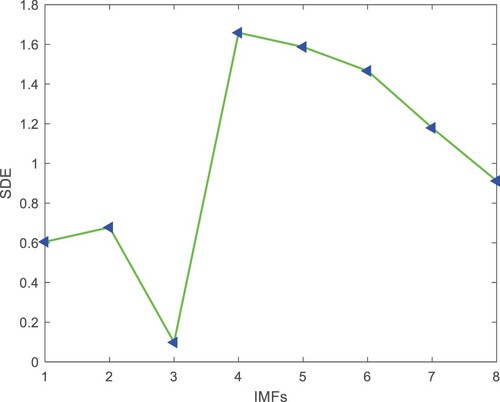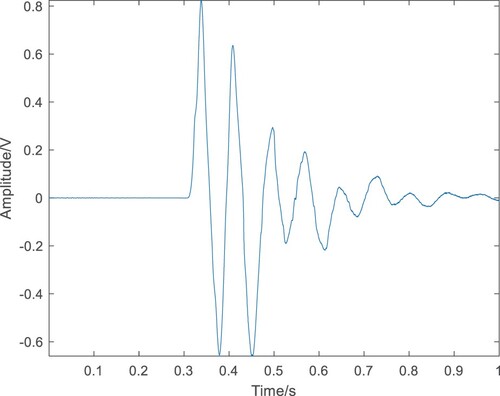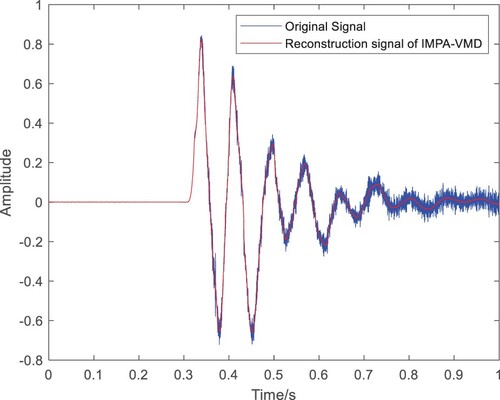 ?Mathematical formulae have been encoded as MathML and are displayed in this HTML version using MathJax in order to improve their display. Uncheck the box to turn MathJax off. This feature requires Javascript. Click on a formula to zoom.
?Mathematical formulae have been encoded as MathML and are displayed in this HTML version using MathJax in order to improve their display. Uncheck the box to turn MathJax off. This feature requires Javascript. Click on a formula to zoom.Abstract
This paper is concerned with the development of improved multi-strategy MPA-VMD method and its application in pipeline leakage detection. Aiming at the shortcomings of the marine predator algorithm (MPA) itself, which has a slow convergence speed and is easy to fall into local optimum, an improved MPA is proposed and used to find two important parameters in variational mode decomposition (VMD), and then dynamic entropy is used to select effective modes. In the initial stage of the population, a good point set strategy is adopted to enhance the search accuracy by increasing the diversity of the initial population; in the search process, a nonlinear convergence factor and the Cauchy distribution are introduced to optimize the predator step size to enhance the global search ability of the algorithm. The ability of the algorithm is enhanced to jump out of the local optimum, and the convergence speed of the algorithm is further improved; the effective mode after VMD is selected by the method of symbolic dynamic entropy. The experimental results show that compared with MPA-VMD, grey wolf optimization-VMD and particle swarm optimization-VMD methods, the devised method has improved signal-to-noise ratio, reduced mean square error and mean absolute error, and has better denoising effect.
1. Introduction
As a common method of energy storage and transportation, pipeline transportation has gradually increased its status in today's society (Hu et al., Citation2021; Ji et al., Citation2021; Lu et al., Citation2021; Wang et al., Citation2020; Yang et al., Citation2022). Because of its high safety, low cost and fast transportation, it has become one of the five major transportation industries. However, due to the longevity of the pipeline itself and the influence of natural disasters and man-made damage, the leakage of the pipeline occurs from time to time. Therefore, it is particularly important to determine efficiently and accurately whether the pipeline leaks to avoid the occurrence of serious disasters (Qui¯nones-Grueiro et al., Citation2021; Zhang et al., Citation2022).
With the rapid development of science and technology, more and more researchers use various signal denoising methods to eliminate the noise signal contained in the pipeline leakage signal to the greatest extent, including wavelet analysis (Chen et al., Citation2005), empirical mode decomposition (EMD) (Huang et al., Citation1998) and filter denoising. EMD is an adaptive signal time-frequency processing method suitable for nonlinear and non-stationary signals, but the signal components decomposed by the EMD method would have the problem of modal aliasing, and it is difficult to select effective modes for reconstruction. The emergence of variational mode decomposition (VMD) (Dragomiretskiy & Zosso, Citation2014) succeeds in suppressing the problem of EMD mode aliasing, but the selection of the two preset parameters K and α in the VMD algorithm and the effective mode after decomposition is very difficult.
Intelligent optimization algorithm, as a rapidly emerging solving method of optimization problem in recent years, can validly and correctly solve the issue that the parameters selection is challenging. The VMD parameters have been optimized by particle swarm intelligence optimization algorithm, and the optimal value of parameter combination has been adaptively selected (Wei et al., Citation2020). Whale optimization algorithm (WOA) has been used to optimize the number of modes K and penalty parameter α in VMD (Zhang et al., Citation2021). Some people have used firefly algorithm to optimize VMD and get the optimal parameters K and α (Li et al., Citation2021). Aiming at the shortcomings of intelligent optimization algorithm involving easily falling into local optimum and slow convergence speed, an improved PSO optimization algorithm has been brought up based on chaos and Sigmoid function, which can successfully solve the defect of PSO algorithm easily falling into local optimal (Zhang et al., Citation2021). The problem of WOA convergence delay has been validly overcome by combining roulette with WOA (Kushwah et al., Citation2021).
To solve the problem that it is difficult to select effective modes of signals decomposed by VMD, a VMD method based on improved Bhattacharyya distance has been developed to select effective components by comparing the similarity between each intrinsic mode function (IMF) component and the original signal (Lu et al., Citation2020). The correlation coefficient method has been used to select effective IMF components with high correlation with the original signal for signal reconstruction (Jiang & Ge, Citation2017). The multi-objective optimization algorithm has been applied to drilling trajectory optimization, which is capable of solving the problem constrained by wellbore stability (Huang et al., Citation2022; Yu et al., Citation2022). A method, combining grey wolf optimization (GWO) algorithm with VMD, has been put forward to optimize the parameters of deep confidence network, which solved the problem that the early fault signal features are weak and easily submerged, resulting in low diagnosis accuracy of bearing weak faults (Jin et al., Citation2022; Shakiba et al., Citation2022).
Based on the above analysis, to find two important parameters of VMD more accurately, improve the signal denoising effect. In this paper, a multi-strategy improved marine predators algorithm (MPA) is proposed. VMD parameters are optimized by this algorithm, and then the IMF decomposed by VMD is reconstructed by using dynamic entropy, so as to complete the denoising of noisy signals.
In summary, the objective of this paper is to improve the intelligent optimization algorithm MPA, enhance the performance of optimization parameters, accurately select effective modes for reconstruction, and apply the reconstructed signal to pipeline leakage detection. The main challenges to be tackled in this paper include: (1) How to solve the unevenness issue of the population initialization of MPA algorithm? (2) How to promote the global search ability of MPA algorithm during the search process? and (3) How to use VMD algorithm to remove noise in pipeline leakage signals? The main contributions of this paper are emphasized as follows: (1) the diversity of population initialization of MPA algorithm is increased by adopting the good point set strategy; (2) both nonlinear convergence factor and Cauchy distribution algorithm are taken into consideration to enhance the global optimization ability of MPA algorithm and (3) dynamic entropy is employed to accurately select the effective modes in VMD algorithm, and the noise in the pipeline leakage signal is filtered out by reconstructing the effective modes.
The structure of this paper is generalized as follows. In Section 2, the relevant theories are given of various improvement strategies. In Section 3, several strategies are adopted to remedy the defects of MPA algorithm. The improved multi-strategy method is verified in Section 4 by a simulation example. The final experimental validation is carried out in Section 5 with the actual data of pipeline leakage, and the conclusion is derived in Section 6.
2. Related theoretical research
2.1. Principle of VMD
VMD is a commonly used signal decomposition method in signal processing. It can adaptively achieve frequency domain division and effective separation of components, and sort frequencies from low frequency to high frequency. The operation process of VMD algorithm consists of two parts: constructing and solving variational models. Among them, the core of constructing the variational model is to solve the constrained optimization variational problem, namely:
(1)
(1) where
is each modal function,
is each central frequency and
is the unilateral spectrum. Spectral modulation is performed by exponential
, and then Gaussian smoothing is employed to demodulate the signal to obtain the bandwidth of each modal function.
In the process of solving the variational model, the augmented Lagrangian function is introduced as follows:
(2)
(2) where α is the penalty parameter and λ is the Lagrange multiplier. Use the alternating direction multiplier algorithm to iteratively solve the above formula. When the iterative conditions of (Equation3
(3)
(3) ) are satisfied, the total number of modes K after decomposition is obtained:
(3)
(3) where ε is the threshold judgment condition.
2.2. Marine predators algorithm
MPA (Faramarzi et al., Citation2020) is a new meta-heuristic optimization algorithm that simulates the relationship between predators and prey through three stages (Ho et al., Citation2021; Li et al., Citation2022; Rezk et al., Citation2022):
Stage 1. Initialization:
Randomly initialize the prey position within the search space as the initial solution:
(4)
(4) where
and
are the search space range, and
is a random number in
.
Stage 2. Optimising: (i) At high velocity ratios or when the prey is moving faster than the predator.
When :
(5)
(5) where
is a random vector containing a normal distribution based on Brownian motion; the symbol ⊗ denotes item-wise multiplication; the multiplication of
and the prey simulates the movement of the prey; P = 0.5;
is a vector of uniform random numbers in
;
represents the maximum number of iterations; and n means the population number. (ii) Unit rate ratio or when both predator and prey are moving at nearly the same speed.
When :
For the first half () of the population:
(6)
(6) For the latter half (
) of the population:
(7)
(7) where
is an adaptive parameter to control the step size of predator movement.
multiplication with the Elite simulates the movement of the predator in Brownian fashion, while the prey follows the movement of the predator in Brownian motion to update its location. (iii) Predators move faster than prey at low rates.
When :
(8)
(8) where the multiplication of
and Elite simulates the movement of predators in Levi's motion (Mantegna, Citation1994). Simultaneously increasing the step size to the elite position simulates predator movement to help update the prey position.
Stage 3. Eddy currents and fish aggregation (FADs) effects:
(9)
(9) where the probability of FADs affecting the optimization process is taken as FADs = 0.2.
is a binary vector of 0s and 1s. r is a uniform random number in the range
.
2.3. Good point set strategy
Since the random initialization is used in the population initialization, it is easy to cause local optimality. To improve the diversity and uniformity of the initial population, the initialization strategy of optimal point set is used to optimize the initialized population (He & Lu, Citation2022; Liu & Li, Citation2010; Sun & Tao, Citation2009). The theory of good point set (Wang et al., Citation2015) has been proposed by Luogeng Hua Hua and Wang (Citation1978) and others, and its basic principle is:
Let be a unit cube in d-dimensional Euclidean space. If
, then the good point set
(
) is defined as follows:
(10)
(10) The deviation is
(11)
(11) where
is a constant related to r and ε, ε is a positive number, and r is a good point. Assuming that the initial population is 200, the scatter plots are displayed in Figure , which are generated by the optimal point set initialization strategy and the random initialization strategy. From Figure , we note that using the optimal point set initialization strategy can generate a better initial population than random initialization within the same range, so that the initial population has a uniform distribution, which is beneficial to enhance the convergence speed and global search ability of the algorithm.
2.4. Improved CF
To enhance the flexibility of the iterative optimization process of optimization algorithms, the weight coefficients have been ameliorated by many scholars (Agrawal, Citation2011; Su, Citation2017; Zhou et al., Citation2010). In this paper, the step CF of MPA algorithm is modified to make the change of CF more consistent with the rule of optimization. The improved CF is defined as follows:
(12)
(12) where Iter is the current iteration number and
is the maximum number of iterations. It is concluded from Figure that with the increase of the number of iterations, the changes of the two step sizes are first slow, then fast and then slow. Compared with the original CF, the improved CF has a slower change in the early stage of the iteration, and the predator moves with a larger step size, which can enhance the global search ability of the algorithm from the initial stage; in the middle of the iteration, the change of the step size of the predator is severe. Rapid decay can increase the possibility of predators searching for better areas; in the later stage of iteration, the change is relatively slow, which is beneficial for predators to keep a small step size and conduct earlier and more comprehensive searches in the newly searched area of merit.
2.5. Cauchy distribution
As a continuous probability distribution, the Cauchy distribution (Wang, Citation1976) can make the optimization algorithm have better global search ability (Gao et al., Citation2020; Qu & He, Citation2010). In this paper, the standard Cauchy transformation form is adopted:
(13)
(13) where atan is the arctangent and θ is a random number in the interval
. The standard Cauchy distribution probability density function and Brownian motion probability density function distribution curves are shown in Figure . The scatter plot of 1000 points is drawn in Figure , which are generated by the standard Cauchy distribution and Brownian motion (Hida, Citation1980) under the same conditions. It is recognized from Figure that although the peak value of the standard Cauchy distribution at the origin is smaller than that of Brownian motion, the two sides are wider and thicker, have a wider distribution range, and obvious heavy tails. Taking advantage of the large proportion of unknown areas with heavy tails in the Cauchy distribution, the perturbation ability of the algorithm is increased, making the algorithm more likely to jump out of the local extreme value, so as to find the global optimal value. From Figure , we can find that when the algorithm is searching for local optimization, the Cauchy distribution can perform more comprehensive optimization in a smaller range than Brownian motion, which shows that the Cauchy distribution has better search performance in local search. To sum up, the Cauchy distribution has better abilities than Brownian motion, including high-precision local search and jumping out of the local optimum easily.
2.6. Symbolic dynamic entropy
Symbolic dynamic entropy (SDE) (Parlitz & Berg, Citation2012) is a kind of entropy that contains available information in a computing system. The larger the value, the more random and irregular the distribution of time series. The smaller the SDE value, the more regular and periodic the distribution of the time series (Duarte et al., Citation2005; Hao, Citation1989). The calculation steps of SDE are mainly divided into five points:
Point 1. Signal sequence symbolization (Monetti et al., Citation2009):
Let the signal sequence , where N is the number of sampling points. Transform the signal sequence X into the symbolic domain
. In the transformation process, it is quantized to between 0 and q−1, where q is the quantization level. When q = 2, the time is quantized to 0 or 1. The specific conversion method is expressed as follows:
(14)
(14) where signal sequence
, symbol sequence
, and r = 0.15 is the threshold.
Point 2. The symbol sequence is truncated: After the sequence conversion, to understand the overall characteristics of the sequence, after a given sequence length L and time delay τ, the sequence is truncated (Zhang, Citation2004), and we get
(15)
(15) where
, N is the data length of the original time series or the data number of the symbol sequence.
Point 3. Decimal conversion: The conversion process (Jin & Li, Citation2004) is described as follows:
(16)
(16) where
, and q is the quantization level.
Point 4. The probability of each pattern appearing in the reconstructed symbol sequence: Count the number of times the decimal sequence appears in each state mode, and calculate the probability of its occurrence denoted as :
(17)
(17) where num is the frequency of occurrence of each state pattern in the reconstructed symbol sequence.
Point 5. Calculate the information entropy of symbolic dynamics (Suo & Li, Citation2022; Yang et al., Citation2022):
(18)
(18) where n is the number of state modes.
Compared with sample entropy and permutation entropy, the SDE method has three main advantages: (1) SDE can better reflect the equivalence of amplitude information in time series; (2) SDE can better reflect the difference of amplitude information in time series and (3) SDE is better able to resist noise or fluctuation interference.
3. Improved MPA algorithm
The implementation steps of the improved MPA algorithm are as follows:
| Step 1. | Input the original signal S, set the population number, iteration number and dimension of MPA and set the search range of VMD parameters. | ||||
| Step 2. | Use the method of good point set initialization to initialize the MPA population. | ||||
| Step 3. | Taking the position of the current predator as the parameter combination | ||||
| Step 4. | Use the improved CF and Cauchy distribution to optimize the optimization process in the iterative process, compare the fitness value, retain the optimal fitness value, and update the predator position. | ||||
| Step 5. | Repeat Step 3 to Step 4 until the maximum number of iterations is reached, the fitness value at this time is the global optimal fitness value, and the corresponding predator position is reserved as the optimal parameter combination | ||||
| Step 6. | Select the effective components for reconstruction by calculating the SDE between the original signal and the probability density function of each IMF. | ||||
The flow chart is depicted in Figure .
4. Simulation experiment verification
To verify the superior performance of the algorithm discussed in this paper, five standard test functions (Alqattan & Abdullah, Citation2015; Dai & Zhan, Citation2005; Pei, Citation2017) are adopted to simulate the four optimization algorithms of MPA, GWO, PSO and IMPA in the experimental stage. is a single-peak test function, which is used to test the development capability of the algorithm.
is a multi-peak test function and
is a fixed-dimensional test function, both of which are used to test the exploration ability of the algorithm. The specific test functions are as Table interprets.
Table 1. Five standard test functions.
In the process of simulation test, the parameters of the four optimization algorithms are set uniformly as follows: the number of populations is 40 and the number of iterations is 500. Using five test functions, the four optimization algorithms are verified in the same dimension, in different search spaces or in different dimensions, and in the same search space. The verification results are shown in Table .
Table 2. Test results of standard test function.
It is presented from Table that in the three test functions of –
, the mean and standard deviation of the optimal value of IMPA are the smallest. The mean value and standard deviation of the optimal IMPA value in
and
are still minimum, which proves the efficient exploration ability of the IMPA algorithm. It is indicated that for different standard test functions, in different dimensions and different search spaces, the development and exploration performance of the IMPA method is higher.
5. Actual data validation
The experimental data used in this paper come from the natural gas pipeline leakage detection simulation experimental platform of Northeast Petroleum University. The total length of the pipeline is 169 m, the diameter is 150 mm and the pressure range is 0–2 MPa. In this paper, the compressed air in the experimental platform is used to simulate the gas pipeline, the pressure is 0.5 MPa, the flow rate is 16 m/s and the leakage diameter is 16 mm (Liang, Citation2019). The waveform of the pipeline data taken is drawn in Figure . The data collected in the laboratory is input as a signal, and the pipeline data is denoised and analysed by the method developed in this paper. First, set the selection range of VMD parameters, namely and
. Then the method investigated in this paper is utilized to optimize the VMD parameters, and the optimization result is
. The optimization result is input into the VMD for signal decomposition, and the decomposition result is shown in Figure . As is observed from Figure , the pipeline data signal is divided into eight components, which are separated and sorted in sequence according to the frequency. It is perceived from Figure that the increment between IMF3 and IMF4 is the largest, so the first three components are effective components, and the last five components are noise components. The line chart is plotted in Figure of dynamic entropy of pipeline signal. The spectrogram after reconstructing the effective components is shown in Figure , and from the comparison between the reconstructed signal and the original signal in Figure , it is revealed that the reconstructed signal can effectively remove the noise signal contained in the original signal.
6. Conclusion
In this paper, a multi-strategy improved MPA method has been proposed based on initialization of good point set and improvement of CF and Cauchy distribution, which overcomes the disadvantages of slow convergence speed and easy to fall into local optimum in the process of iterative optimization of MPA. A more accurate parameter combination has been found via the improved MPA to find VMD parameters, where it can well jump out of the local optimum, and quickly search the global optimum. The effective mode after VMD has been selected by dynamic entropy, and then the effective mode has been reconstructed to get the denoised signal. It has been illustrated by the experimental results that the raised method achieves efficient signal denoising with higher SNR, lower MSE and MAE, and capability of distinguishing effective components and noise components more accurately.
Table 3. Comparison of denoising effects of actual data.
The future research topic is to further improve the algorithm by referring to the characteristics of other algorithms, such as optimization algorithm (An et al., Citation2022; Govindasamy & Antonidoss, Citation2022; Han et al., Citation2020; Song et al., Citation2022, Citation2021; Xu et al., Citation2021), chaotic initialization algorithm (Li, Citation2019; Wu et al., Citation2020), model-based filtering/control algorithm (Li et al., Citation2021, Citation2020, Citation2022; Liu et al., Citation2022; Wen et al., Citation2022; Zhang et al., Citation2021; Zhang & Zhou, Citation2022), so as to achieve higher accuracy and speed.
Disclosure statement
No potential conflict of interest was reported by the author(s).
Additional information
Funding
References
- Agrawal, A. (2011). An improved fuzzy adaptive firefly algorithm-based hybrid clustering algorithms. International Journal of Uncertainty, Fuzziness and Knowledge-Based Systems, 29(2), 259–278. https://doi.org/10.1142/S0218488521400146
- Alqattan, Z. N., & Abdullah, R. (2015). A hybrid artificial bee colony algorithm for numerical function optimization. International Journal of Modern Physics C, 26(10), 1550109. https://doi.org/10.1142/S0129183115501090
- An, W., Zhao, P., Liu, H., & Hu, J. (2022). Distributed multi-step subgradient projection algorithm with adaptive event-triggering protocols: A framework of multiagent systems. International Journal of Systems Science, 53(13), 2758–2772. https://doi.org/10.1080/00207721.2022.2063967
- Chen, J., Zeng, S.-P., & Yang, X.-M. (2005). Leakage fault diagnosis of hydraulic system based on wavelet analysis. In Wavelet Analysis and Active Media Technology (pp. 971–975).
- Dai, G., & Zhan, W. (2005). A high-efficiency hybrid evolutionary algorithm for solving function optimization problem. In Proceedings of the 11th Joint International Computer Conference (pp. 519–522).
- Dragomiretskiy, K., & Zosso, D. (2014). Variational mode decomposition. IEEE Transactions on Signal Processing, 62(3), 531–544. https://doi.org/10.1109/TSP.2013.2288675
- Duarte, J., Silva, L., & Ramos, J. S. (2005). Symbolic dynamics in the study of bursting electrical activity. In Difference Equations and Discrete Dynamical Systems (pp. 313–324).
- Faramarzi, A., Heidarinejad, M., Mirjalili, S., & Gandomi, A. H. (2020). Marine predators algorithm: A nature-inspired metaheuristic. Expert Systems with Applications, 152, 113377. https://doi.org/10.1016/j.eswa.2020.113377
- Gao, W., Liu, S., Xiao, Z., & Yu, J. (2020). Butterfly optimization algorithm based on Cauchy variation and adaptive weight. Computer Engineering and Applications, 56(15), 43–50. https://doi.org/10.3778/j.issn.1002-8331.1907-0048
- Govindasamy, C., & Antonidoss, A. (2022). Enhanced inventory management using blockchain technology under cloud sector enabled by hybrid multi-verse with whale optimization algorithm. International Journal of Information Technology & Decision Making, 21(02), 577–614. https://doi.org/10.1142/S021962202150067X
- Han, Q., Zhang, X., Xu, K., & Du, X. (2020). Free parameter optimization of DTMDs based on improved hybrid genetic-simulated annealing algorithm. International Journal of Structural Stability and Dynamics, 20(03), 2050031. https://doi.org/10.1142/S0219455420500315
- Hao, B.-L. (1989). Elementary symbolic dynamics and chaos in dissipative systems. World Scientific.
- He, G., & Lu, X.-L. (2022). Good point set and double attractors based-QPSO and application in portfolio with transaction fee and financing cost. Expert Systems with Applications, 209, 118339. https://doi.org/10.1016/j.eswa.2022.118339
- Hida, T. (1980). Brownian motion. Springer. pp. 44–113.
- Ho, L. V., Nguyen, D. H., Mousavi, M., Roeck, G. D., Bui-Tien, T., Gandomi, A. H., & Wahab, M. A. (2021). A hybrid computational intelligence approach for structural damage detection using marine predator algorithm and feedforward neural networks. Computers and Structures, 252, 106568. https://doi.org/10.1016/j.compstruc.2021.106568
- Hu, X., Zhang, H., Ma, D., Wang, R., & Zheng, J. (2021). Minor class-based status detection for pipeline network using enhanced generative adversarial networks. Neurocomputing, 424, 71–83. https://doi.org/10.1016/j.neucom.2020.11.009
- Hua, L., & Wang, Y. (1978). The application of number theory in approximate analysis. Science Press.
- Huang, N. E., Shen, Z., Long, S. R., Wu, M. C., Shih, H. H., Zheng, Q., Yen, N.-C., Tung, C. C., & Liu, H. H. (1998). The empirical mode decomposition and the Hilbert spectrum for nonlinear and non-stationary time series analysis. Proceedings of the Royal Society of London Series A: Mathematical, Physical and Engineering Sciences, 454(1971), 903–995. https://doi.org/10.1098/rspa.1998.0193
- Huang, W., Wu, M., Hu, J., Chen, L., Lu, C., Chen, X., & Cao, W. (2022). A multi-objective optimisation algorithm for a drilling trajectory constrained to wellbore stability. International Journal of Systems Science, 53(1), 154–167. https://doi.org/10.1080/00207721.2021.1941396
- Ji, D., Wang, C., Li, J., & Dong, H. (2021). A review: Data driven-based fault diagnosis and RUL prediction of petroleum machinery and equipment. Systems Science & Control Engineering, 9(1), 724–747. https://doi.org/10.1080/21642583.2021.1992684
- Jiang, J., & Ge, Y. (2017). Application of variational mode decomposition and correlation coefficient joint algorithm in pipeline leak detection. Pressure Vessel, 33(12), 59–63. https://doi.org/10.1088/2631-8695/abcc47
- Jin, N., & Li, W. (2004). Study on the analysis method of nonlinear symbolic time series. Journal of Dynamics and Control, 2(3), 54–59.
- Jin, Z., He, D., & Wei, Z. (). Intelligent fault diagnosis of train axle box bearing based on parameter optimization VMD and improved DBN. Engineering Applications of Artificial Intelligence, 110, 104713. https://doi.org/10.1016/j.engappai.2022.104713.
- Kushwah, R., Kaushik, M., & Chugh, K. (2021). A modified whale optimization algorithm to overcome delayed convergence in artificial neural networks. Soft Computing, 25(15), 10275–10286. https://doi.org/10.1007/s00500-021-05983-z
- Li, C., Wang, Z., Song, W., Zhao, S., Wang, J., & Shan, J. (2022). Resilient unscented Kalman filtering fusion with dynamic event-triggered scheme: applications to multiple unmanned aerial vehicles. IEEE Transactions on Control Systems Technology, 31(1), 370–381. https://doi.org/10.1109/TCST.2022.3180942
- Li, D., Lu, Q., & Song, H. (2021). Fault detection of rolling bearings based on firefly algorithm optimization of VMD. Machine Tools and Hydraulics, 49(15), 195–199.
- Li, J., Dong, H., Liu, H., & Han, F. (2021). Sampled-data non-fragile state estimation for delayed genetic regulatory networks under stochastically switching sampling periods. Neurocomputing, 463, 168–176. https://doi.org/10.1016/j.neucom.2021.07.093
- Li, X., Han, F., Hou, N., Dong, H., & Liu, H. (2020). Set-membership filtering for piecewise linear systems with censored measurements under Round-Robin protocol. International Journal of Systems Science, 51(9), 1578–1588. https://doi.org/10.1080/00207721.2020.1768453
- Li, Y. (2019). Cloud computing resource load forecasting based on bat algorithm optimized SVM. International Journal of Performability Engineering, 15(7), 1955–1964. https://doi.org/10.23940/ijpe.19.07.p23.19551964
- Li, Z., Wang, B., Zhu, B., Wang, Q., & Zhu, W. (2022). Thermal error modeling of electrical spindle based on optimized ELM with marine predator algorithm. Case Studies in Thermal Engineering, 38, 102326. https://doi.org/10.1016/j.csite.2022.102326
- Liang, H. (2019). Research on acoustic signal detection and recognition technology for oil and gas pipeline leakage, Doctoral Dissertation of Northeast Petroleum University, Daqing.
- Liu, Y., & Li, S. (2010). Hybrid good point set evolutionary strategy for constrained optimization. Advanced Intelligent Computing Theories and Applications, 93, 30–39. https://doi.org/10.1007/978-3-642-14831-6
- Liu, Z., Lin, W., Yu, X., Rodríguez-Andina, J. J., & Gao, H. (2022). Approximation-free robust synchronization control for dual-linear-motors-driven systems with uncertainties and disturbances. IEEE Transactions on Industrial Electronics, 69(10), 10500–10509. https://doi.org/10.1109/TIE.2021.3137619
- Lu, J., Yue, J., Zhu, L., & Li, G. (2020). Variational mode decomposition denoising combined with improved Bhattacharyya distance. Measurement, 151, 107283. https://doi.org/10.1016/j.measurement.2019.107283
- Lu, J., Yue, J., Zhu, L., Wang, D., & Li, G. (2021). An improved variational mode decomposition method based on the optimization of salp swarm algorithm used for denoising of natural gas pipeline leakage signal. Measurement, 185, 110107. https://doi.org/10.1016/j.measurement.2021.110107
- Mantegna, R. N. (1994). Fast, accurate algorithm for numerical simulation of Lévy stable stochastic processes. Physical Review E, 49(5), 4677–4683. https://doi.org/10.1103/PhysRevE.49.4677
- Monetti, R., Bunk, W., & Jamitzky, F. (2009). Analysing time series using symbolic representations. Topics on Chaotic Systems, 242–250. https://doi.org/10.1142/9789814271349_0028
- Parlitz, U., & Berg, S. (2012). Classifying cardiac biosignals using ordinal pattern statistics and symbolic dynamics. Computers in Biology and Medicine, 42(3), 319–327. https://doi.org/10.1016/j.compbiomed.2011.03.017
- Pei, S. (2017). Hybrid immune clonal particle swarm optimization multi-objective algorithm for constrained optimization problems. International Journal of Pattern Recognition and Artificial Intelligence, 31(01), 1759001. https://doi.org/10.1142/S0218001417590017
- Qu, L., & He, D. (2010). Artificial fish-school algorithm based on adaptive Cauchy mutation and its applications. Microelectronics & Computer, 27(10), 74–78. https://doi.org/10.19304/j.cnki.issn1000-7180.2010.10.018
- Qui¯nones-Grueiro, M., Milián, M. A., Rivero, M. S., Neto, A. J. S., & Llanes-Santiago, O. (2021). Robust leak localization in water distribution networks using computational intelligence. Neurocomputing, 438, 195–208. https://doi.org/10.1016/j.neucom.2020.04.159
- Rezk, H., Inayat, A., Abdelkareem, M. A., Olabi, A. G., & Nassef, A. M. (2022). Optimal operating parameter determination based on fuzzy logic modeling and marine predators algorithm approaches to improve the methane production via biomass gasification. Energy, 239, 122072. https://doi.org/10.1016/j.energy.2021.122072
- Shakiba, F. M., Shojaee, M., Azizi, S. M., & Zhou, M. (2022). Real-time sensing and fault diagnosis for transmission lines. International Journal of Network Dynamics and Intelligence, 1(1), 36–47. https://doi.org/10.53941/ijndi0101004
- Song, B., Miao, H., & Xu, L. (2021). Path planning for coal mine robot via improved ant colony optimization algorithm. Systems Science & Control Engineering, 9(1), 283–289. https://doi.org/10.1080/21642583.2021.1901158
- Song, J., Li, H., & He, X. (2022). A high-precision distributed micro-displacement monitoring system: System design and data processing algorithms. IEEE Transactions on Instrumentation and Measurement, 71, 3513509. https://doi.org/10.1109/TIM.2022.3174307.
- Su, Y.-H. (2017). The research on breaker fault status parameter classify based on the improved particle swarm optimization of SVM. Mechanical Engineering and Control Systems (pp. 296–309).
- Sun, H., & Tao, L. (2009). Parameter selection algorithm for support vector machines based on good point set based genetic algorithm. Computer Technology and Development, 19(8), 86–88.
- Suo, J., & Li, N. (2022). Observer-based synchronisation control for discrete-time delayed switched complex networks with coding-decoding approach. International Journal of Systems Science, 53(13), 2711–2728.https://doi.org/10.1080/00207721.2022.2083257
- Wang, C., Han, F., Zhang, Y., & Lu, J. (2020). An SAE-based resampling SVM ensemble learning paradigm for pipeline leakage detection. Neurocomputing, 403, 237–246. https://doi.org/10.1016/j.neucom.2020.04.105
- Wang, P., Li, L., Gao, W., & Wang, S. (2015). Hybrid reverse learning artificial fish swarm algorithm using good point sets. Computer Application Research, 32(7), 1992–1995.
- Wang, Z. (1976). The basis of probability theory and its application. Science Press.
- Wei, Y., Jiang, Q., & Cao, H. (2020). Rotor rubbing identification based on PSO optimization of VMD and SVM. Journal of Shenyang University of Technology, 39(4), 42–47.
- Wen, P., Dong, H., Huo, F., Li, J., & Lu, X. (2022). Observer-based PID control for actuator-saturated systems under binary encoding scheme. Neurocomputing, 499, 54–62. https://doi.org/10.1016/j.neucom.2022.05.035
- Wu, Y., Liu, J., & Li, D. (2020). Chaotic dynamically dimensioned search algorithm. IEEE Access, 8, 152474–152499. https://doi.org/10.1109/Access.6287639
- Xu, L., Song, B., & Cao, M. (2021). An improved particle swarm optimization algorithm with adaptive weighted delay velocity. Systems Science & Control Engineering, 9(1), 188–197. https://doi.org/10.1080/21642583.2021.1891153
- Yang, D., Hou, N., Lu, J., & Ji, D. (2022). Novel leakage detection by ensemble 1DCNN-VAPSO-SVM in oil and gas pipeline systems. Applied Soft Computing, 115, 108212. https://doi.org/10.1016/j.asoc.2021.108212
- Yang, F., Li, J., Dong, H., & Shen, Y. (2022). Proportional-integral-type estimator design for delayed recurrent neural networks under encoding-decoding mechanism. International Journal of Systems Science, 53(13), 2729–2741. https://doi.org/10.1080/00207721.2022.2063968
- Yu, N., Yang, R., & Huang, M. (2022). Deep common spatial pattern based motor imagery classification with improved objective function. International Journal of Network Dynamics and Intelligence, 1(1), 73–84. https://doi.org/10.53941/ijndi0101007
- Zhang, C., Hou, N., Lu, J., & Wang, C. (2021). Improved PSO-VMD algorithm and its application in pipeline leak detection. Journal of Jilin University (Information Science Edition), 39(1), 28–39. https://doi.org/10.19292/j.cnki.jdxxp.2021.01.005
- Zhang, H., Pan, D., Liu, J., & Jiang, Z. (2022). A novel MAS-GAN-based data synthesis method for object surface defect detection. Neurocomputing, 499, 106–114. https://doi.org/10.1016/j.neucom.2022.05.021
- Zhang, J., Song, J., Li, J., Han, F., & Zhang, H. (2021). Observer-based non-fragile H∞-consensus control for multi-agent systems under deception attacks. International Journal of Systems Science, 52(6), 1223–1236. https://doi.org/10.1080/00207721.2021.1884917
- Zhang, P., Zhang, W., Zhao, X., Wu, X., & Liu, N. (2021). Application of WOA-VMD algorithm in bearing fault diagnosis. Noise and Vibration Control, 41(4), 86–93.
- Zhang, Q., & Zhou, Y. (2022). Recent advances in non-Gaussian stochastic systems control theory and its applications. International Journal of Network Dynamics and Intelligence, 1(1), 111–119. https://doi.org/10.53941/ijndi0101010
- Zhang, Y. (2004). Symbolic time series analysis. Journal of Xiangtan Institute of Mining and Technology, 19(1), 75–79.
- Zhou, Y., Wei, M., & Sun, W. (2010). Parameter optimization of PID controller based on quantum-behaved particle swarm optimization algorithm with weight coefficient. Computer Engineering and Applications, 46(5), 224–228.

